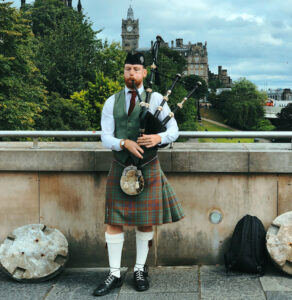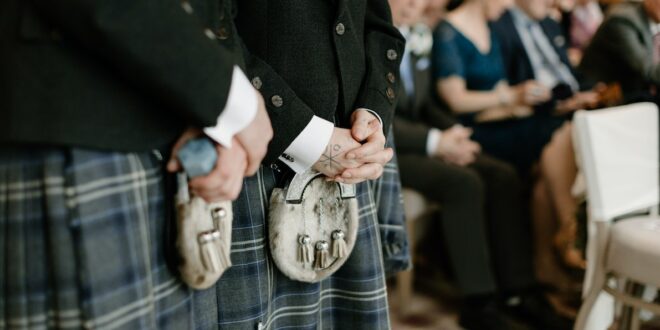The lead-up to the late Queen Elizabeth II’s funeral was a marvel of pageantry, and a close-up look at the magnificent regalia worn by all involved. But perhaps the dress code New Zealanders were most interested in, given the Scottish heritage of so many of its citizens, was that of the Highlanders. From hand knitted hose to daggers in places we hadn’t even noticed before, the elaborate tartan ‘uniform’ had some of us completely befuddled. If you’re still in a state of confusion, let us explain some of the more unusual bits and pieces of the Highland dress code for you:
 The sporran
The sporran
‘Sporran’ is the Gaelic word for ‘purse’. While sporrans are now more decorative than practical objects, they would once have been used to carry every day items such as coins, fire lighting materials, and food. Sporrans are usually made from animal skin (such as deer or goat hide). Plain leather would have been the order of the day for working men, but dress attire might dictate a hair sporran, or one embellished with decorative pieces of metal such as silver or brass. Very rarely, an animal head might act as a sporran – which must have been an unusual sight!
Sporrans are designed to thread onto a narrow belt which goes through loops at the waist of the kilt. It is important the sporran hangs at the correct distance from the belt. The generally accepted correct distance is 5-7.5cm below the belt buckle.
Sgian Dubh
If you’ve ever noticed a small knife (in its sheath) tucked into the hose (stocking – or long sock) of a Highlander, you’re looking at a sgian dubh. The Gaelic terms translates as ‘black knife,’ and once upon a time, it was very much a part of self defence. Originally, this short knife was kept in a Highlander’s armpit where it couldn’t be seen, but could be quickly accessed. As times have become more civilised, the need for the knife hasn’t been so great, and Highlanders now feel safe tucking it into their sock (where it it more difficult to reach but presumably more convenient to store).
Although it’s illegal to carry a weapon in Scotland, Scottish police adopt a common sense approach to the wearing of sgian dubh, and don’t bother anyone who has one tucked into their hose (unless they withdraw it and start acting rashly).
Kilt hose
The long socks worn by Highlanders were traditionally hand knitted (if you check out photos of King Charles in Highland attire in the lead-up to the late Queen Elizabeth II’s funeral, you’ll see just how plain these can be). However, there are also more complex, tartan, machine-made hose now available. Although hose are usually thought of as being knee-high, they are actually intended to be worn 2-3 ‘fingers’ below the bottom of the knee cap. And just how they are held up at this height is a matter for ‘the garter!’
The garter and its ‘flashes’
A ‘garter’ is a length of elastic which stretches around the leg to hold up the hose. At each end of the garter are metal clips which lock together to hold the elastic in place. Garter ‘flashes’ are strips of fabric which attach to the garter (they are designed to match the fabric of the kilt). Once the garter is clipped in place, the top of the hose is turned down, and the flashes hang down beneath it. They are worn on the outside of the leg.
While Highlanders are proud of their dress, its tradition was threatened by a law called the ‘Dress Act of 1746’. A political move, it banned the wearing of the kilt (and other aspects of Highland dress). This law wasn’t repealed until 1872, by which time, many Highlanders had begun wearing trousers as everyday dress. Whenever you see a Highlander in full regalia, remind yourself how lucky we are to still have it!









Join the Discussion
Type out your comment here:
You must be logged in to post a comment.